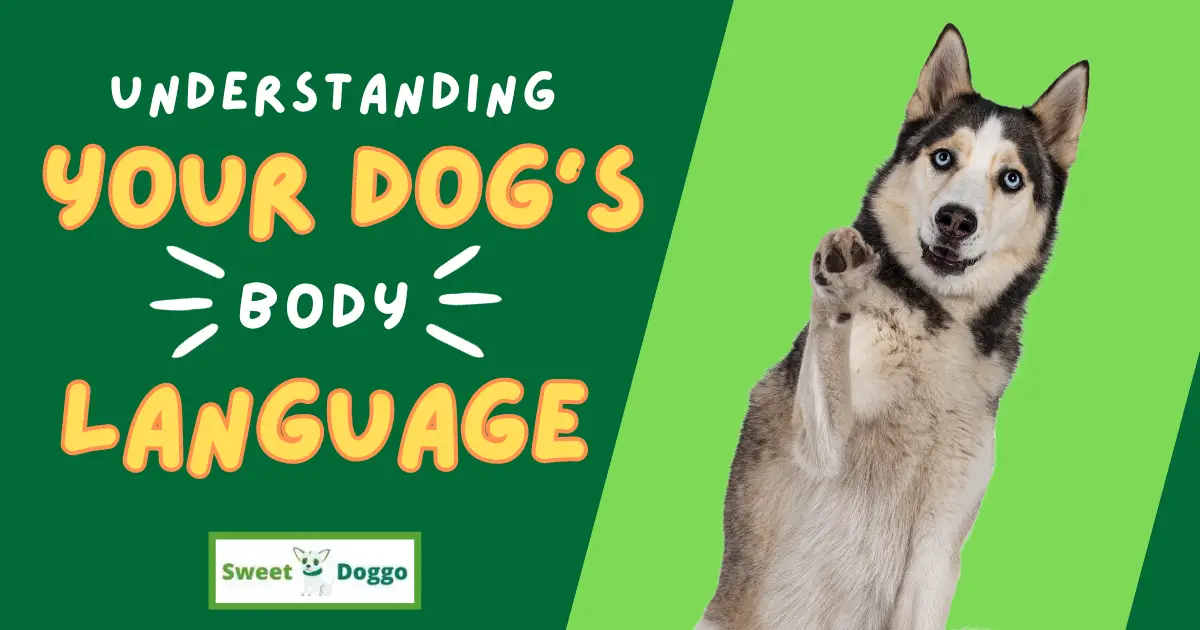Table of Contents
Decoding Your Canine Companion’s Signals
1. Why is it important to understand dog body language?
Understanding dog body language is crucial for any dog owner or enthusiast. Dogs primarily communicate through non-verbal cues, and being able to interpret their body language can help you better understand their needs, emotions, and overall well-being. It can also help prevent misunderstandings, reduce the risk of aggression or fear-based reactions, and strengthen the bond between you and your furry friend.
By learning to read your dog’s body language, you can anticipate their reactions, identify signs of stress or discomfort, and adjust your approach accordingly. This knowledge is particularly valuable when introducing your dog to new environments, other dogs, or unfamiliar people.
Additionally, understanding dog body language can be beneficial in professional settings, such as dog training, veterinary care, or working with therapy dogs. It allows professionals to assess a dog’s behavior and tailor their approach to ensure the dog’s well-being and success in various situations.
2. How can I interpret a dog’s tail wagging?
Tail wagging is one of the most recognizable and commonly misunderstood dog body language signals. While many people associate tail wagging with happiness, it’s essential to consider the context and other accompanying cues.
A relaxed, loose tail wagging from side to side at a medium height is often a sign of a friendly and content dog. However, a stiff, high-held tail wagging rapidly can indicate arousal, excitement, or even aggression. On the other hand, a tucked tail between the hind legs usually signifies fear, anxiety, or submission.
It’s crucial to observe the entire body language, including the position of the ears, body posture, and facial expressions, to accurately interpret a dog’s tail wagging. By considering the overall context, you can better understand your dog’s emotions and respond appropriately.
For a more in-depth understanding of dog tail wagging, you can read our article on Understanding Dog Tail Wagging.
3. What are the signs of dog-to-dog communication?
Dogs communicate with each other using a variety of signals, both verbal and non-verbal. Understanding these signs can help you assess the dynamics between dogs and ensure positive interactions.
Some common signs of dog-to-dog communication include:
- Body posture: Dogs may exhibit dominant or submissive postures to establish their social rank.
- Facial expressions: Raised eyebrows, relaxed or tense facial muscles, and direct or averted eye contact can convey different messages.
- Ear position: Erect ears may indicate alertness or assertiveness, while flattened ears can signal fear or submission.
- Tail position: A high-held tail can indicate confidence or dominance, while a tucked tail suggests fear or submission.
- Vocalizations: Dogs may use barks, growls, whines, or howls to communicate various emotions or intentions.
- Play behavior: Play bows, relaxed body movements, and gentle mouthing are often signs of friendly play.
It’s important to remember that individual dogs may have unique communication styles, and their signals should be interpreted in the context of the specific situation and the dogs involved. For a more comprehensive understanding of dog-to-dog communication, you can refer to our article on <a”Dog-to-Dog Communication Signs” at https://sweetdoggo.com/dog-to-dog-communication-signs.
4. What does it mean when a dog has white eyes?
White eyes, also known as “whale eye” or “half-moon eye,” refer to the appearance of the whites of a dog’s eyes being visible. This can be an important indicator of a dog’s emotional state and should be interpreted in conjunction with other body language cues.
According to the The American Kennel Club , whale eye occurs when a dog’s pupils dilate and their gaze becomes fixed on a potential threat, suggesting that they are feeling anxious, fearful, or stressed. It often happens when a dog is feeling threatened or uncomfortable in a particular situation, such as being hugged, cornered, or approached by strangers.
The The Dogster website also explains that whale eye is a warning signal that your dog is feeling threatened or anxious, and that you should not ignore it or punish your dog for it. Instead, you should give the dog space and avoid any actions that may escalate their anxiety. By recognizing the signs of whale eye, you can help alleviate the dog’s stress and create a safer environment for them.
If you want to learn more about the meaning of dog white eyes, you can also check out our article on The Meaning of Dog Whale Eye.
White eyes, also known as “whale eye” or “half-moon eye,” refer to the appearance of the whites of a dog’s eyes being visible. This can be an important indicator of a dog’s emotional state and should be interpreted in conjunction with other body language cues.
When a dog shows white eyes, it typically suggests that they are feeling anxious, fearful, or stressed. It often occurs when a dog is feeling threatened or uncomfortable in a particular situation. The whites of the eyes become more visible as the dog’s pupils dilate and their gaze becomes fixed on a potential threat.
It’s important to give the dog space and avoid any actions that may escalate their anxiety. By recognizing the signs of white eyes, you can help alleviate the dog’s stress and create a safer environment for them.
If you want to delve deeper into the meaning of dog white eyes, you can read our article on The Meaning of Dog Whale Eye.
5. How can I interpret dog vocalizations?
Dogs use a wide range of vocalizations to communicate their needs, emotions, and intentions. Understanding these vocal cues can provide valuable insights into your dog’s state of mind.
Common dog vocalizations include:
- Barking: Dogs bark for various reasons, such as alerting to potential threats, expressing excitement, seeking attention, or signaling discomfort.
- Growling: Growling is often a warning sign that a dog is feeling threatened, fearful, or defensive.
- Whining: Whining can indicate a range of emotions, including anxiety, frustration, or a desire for attention or comfort.
- Howling: Howling is a form of vocalization often associated with communication over long distances or in response to certain sounds.
It’s essential to consider the context, accompanying body language, and the individual dog’s vocalization patterns to accurately interpret their meaning. By paying attention to these cues, you can better understand your dog’s needs and respond appropriately.
If you’re interested in learning more about interpreting dog vocalizations, you can refer to our article on Interpreting Dog Vocalizations.
6. How does dog posture reflect their mood?
A dog’s posture can provide valuable insights into their mood, confidence level, and intentions. By observing their body position and movements, you can better understand what your dog is trying to communicate.
Some common dog postures and their associated meanings include:
- Relaxed posture: A relaxed dog will have a loose body, with weight evenly distributed on all four legs. They may exhibit a gentle wagging tail and soft facial expressions.
- Tense posture: A dog with a tense posture will have stiff body language, raised hackles, and a rigid tail. They may be on high alert or feeling threatened.
- Submissive posture: A submissive dog will lower their body, tuck their tail between their legs, and avert their gaze to avoid direct eye contact. They may also roll onto their back or expose their belly as a sign of submission.
- Aggressive posture: An aggressive dog will display a more dominant and assertive posture. They may stand tall, with a stiff body, raised tail, and forward-leaning stance. Their ears may be erect, and they may make themselves appear larger by puffing up their fur.
- Playful posture: A dog in a playful mood will have a bouncy and energetic posture. They may engage in play bows, where they lower their front end while keeping their hind end raised, signaling an invitation to play.
It’s important to consider the overall context and other body language cues when interpreting a dog’s posture. By understanding their mood and intentions, you can respond appropriately and ensure a positive interaction.
If you want to learn more about interpreting dog posture and mood, you can read our article on Understanding Dog Posture and Mood.
7. How can I interpret dog facial expressions?
Dogs have a wide range of facial expressions that can convey their emotions and intentions. By paying attention to their facial cues, you can gain valuable insights into their state of mind.
Some common dog facial expressions and their meanings include:
- Relaxed face: A relaxed dog will have a soft and open expression. Their mouth may be slightly open, and their eyes will appear relaxed and friendly.
- Tense face: A dog with a tense face may have a furrowed brow, narrowed eyes, and tightly closed mouth. These signs can indicate fear, anxiety, or aggression.
- Submissive face: A submissive dog will avert their gaze, lower their head, and expose their tongue or lick their lips. They may also pull their ears back against their head.
- Alert face: An alert dog will have wide eyes, raised eyebrows, and forward-facing ears. They may be focused on something in their environment.
- Playful face: A dog in a playful mood may have a relaxed mouth, bright eyes, and a slightly open tongue. They may also have a “smiling” expression, with their lips pulled back.
It’s important to consider the entire context and other body language cues when interpreting a dog’s facial expressions. By understanding their emotions, you can respond appropriately and ensure their comfort and well-being.
If you’re interested in learning more about interpreting dog facial expressions, you can refer to our article on Interpreting Dog Facial Expressions.
8. What does it mean when a dog’s hackles are raised?
Raised hackles, also known as piloerection, refer to the phenomenon where the fur along a dog’s back and neck stands on end. This can be an important indicator of their emotional state and should be interpreted in conjunction with other body language cues.
When a dog’s hackles are raised, it typically suggests that they are feeling aroused, threatened, or fearful. It is an involuntary response triggered by the sympathetic nervous system. The raised hackles make the dog appear larger and more intimidating as a defensive mechanism.
It’s important to approach a dog with raised hackles cautiously and give them space. Avoid any actions that may escalate their anxiety or fear. By recognizing the signs of raised hackles, you can help create a calmer and safer environment for the dog.
If you want to delve deeper into the meaning of raised dog hackles, you can read our article on The Meaning of Raised Dog Hackles.
9. How does dog body language vary among different breeds?
While there are universal aspects of dog body language, it’s important to note that certain breeds may have specific traits or characteristics that influence their communication style.
Breed-specific body language variations can include:
- Tail carriage: Some breeds naturally have curled or docked tails, which can affect their tail language. For example, a breed with a naturally curly tail may have a different tail position when compared to a breed with a straight tail.
- Ear shape and position: Different breeds have distinct ear shapes and positions, which can influence their ability to communicate through ear movements. For example, breeds with floppy ears may have less visible ear cues compared to breeds with erect ears.
- Muzzle shape: The shape of a dog’s muzzle can impact their facial expressions. Breeds with shorter muzzles, such as brachycephalic breeds, may have different facial expressions compared to breeds with longer muzzles.
- Body size and structure: The size and structure of a dog’s body can affect their overall posture and movement. For example, a large and muscular breed may have a more imposing presence compared to a small and delicate breed.
While breed-specific variations exist, it’s important to remember that individual dogs within a breed can still have unique body language cues. It’s crucial to observe and understand the specific dog’s body language rather than relying solely on breed stereotypes.
If you’re interested in learning more about breed-specific dog body language, you can refer to our article on Breed-Specific Dog Body Language.
10. How does dog body language change with age?
Just like humans, dogs’ body language can change as they age. Understanding these changes can help you adapt your interactions and provide appropriate care for your aging canine companion.
Some common changes in dog body language with age include:
- Reduced mobility: Older dogs may exhibit slower movements, stiffness, or difficulty getting up or lying down. These changes in mobility can be reflected in their overall body language.
- Decreased energy levels: As dogs age, they may have lower energy levels and engage in less vigorous play or exercise. Their body language may appear more relaxed and less exuberant.
- Increased sleep: Older dogs tend to sleep more, and their body language during sleep may differ from when they are awake. They may curl up more tightly or have a more relaxed posture while sleeping.
- Changes in facial expressions: Aging dogs may develop gray hair around the muzzle or have droopier skin, which can affect their facial expressions. Their eyes may appear more tired or have a cloudier appearance due to age-related conditions.
- Altered social interactions: Older dogs may become more selective in their social interactions and may prefer the company of familiar individuals or dogs. They may display less interest in engaging with unfamiliar dogs or may exhibit more caution in their body language.
It’s important to be aware of these changes and adjust your expectations and care accordingly. Providing a comfortable and supportive environment for your aging dog can help them navigate these changes with ease.
If you want to learn more about how dog body language changes with age, you can read our article on Changes in Dog Body Language with Age.
11. How can I improve training by understanding dog body language?
Understanding dog body language can greatly enhance your training efforts and improve communication between you and your dog. By being attuned to their body language cues, you can better gauge their level of comfort, engagement, and understanding during training sessions.
Here are some ways you can improve training by understanding dog body language:
- Recognize stress signals: Dogs may exhibit stress signals such as lip licking, yawning, or turning away when they are feeling overwhelmed or anxious during training. By recognizing these signals, you can adjust the training environment or techniques to alleviate their stress and create a more positive learning experience.
- Use positive reinforcement: Positive reinforcement training relies on rewarding desired behaviors. By observing your dog’s body language, you can identify when they are exhibiting the desired behavior and promptly reward them. This helps reinforce the connection between the behavior and the reward.
- Adjust training intensity: Dogs have different energy levels and attention spans. By reading their body language, you can gauge when they are becoming fatigued or losing focus. Taking regular breaks and adjusting the training intensity can help keep your dog engaged and motivated.
- Tailor training methods: Different dogs respond better to different training methods. By understanding your dog’s body language, you can determine if they are more responsive to visual cues, verbal cues, or physical cues. This allows you to tailor your training methods to their individual learning style.
- Build trust and rapport: Understanding your dog’s body language helps you build trust and strengthen your bond. By recognizing when they are comfortable, relaxed, and engaged, you can create a positive training environment that fosters trust and cooperation.
By incorporating an understanding of dog body language into your training approach, you can create a more effective and enjoyable training experience for both you and your dog.
If you’re interested in learning more about improving training with dog body language, you can refer to our article on Improving Training with Dog Body Language.
Conclusion
Understanding dog body language is a valuable skill for any dog owner or enthusiast. By interpreting their signals, such as tail wagging, facial expressions, and posture, you can gain insights into their emotions, needs, and intentions. This knowledge allows you to better communicate with your dog, prevent misunderstandings, and strengthen your bond. Whether you’re training your dog, introducing them to new situations, or simply wanting to enhance your connection, learning to read their body language is an essential tool. By investing time and effort into understanding dog body language, you can create a harmonious and fulfilling relationship with your canine companion.
| Question | Summary |
|---|---|
| Why is it important to understand dog body language? | Understanding dog body language helps prevent misunderstandings, reduce aggression, and strengthen the bond between dogs and their owners. |
| How can I interpret a dog’s tail wagging? | Tail wagging can indicate different emotions depending on the context and accompanying cues. |
| What are the signs of dog-to-dog communication? | Dogs communicate with each other through body posture, facial expressions, ear position, tail position, vocalizations, and play behavior. |
| What does it mean when a dog has white eyes? | White eyes indicate anxiety, fear, or stress in dogs. |
| How can I interpret dog vocalizations? | Dogs use barking, growling, whining, and howling to communicate various emotions and intentions. |
| How does dog posture reflect their mood? | Dog posture can indicate relaxation, tension, submission, aggression, or playfulness. |
| How can I interpret dog facial expressions? | Dogs have various facial expressions that convey their emotions, such as relaxation, tension, submission, alertness, or playfulness. |
| What does it mean when a dog’s hackles are raised? | Raised hackles indicate arousal, threat, or fear in dogs. |
| How does dog body language vary among different breeds? | Breed-specific traits can influence the way dogs communicate through body language. |
| How does dog body language change with age? | As dogs age, their body language may reflect reduced mobility, decreased energy levels, increased sleep, changes in facial expressions, and altered social interactions. |
| How can I improve training by understanding dog body language? | Understanding dog body language helps in recognizing stress signals, using positive reinforcement, adjusting training intensity, tailoring training methods, and building trust and rapport. |
FAQ
1. Why is it important to understand dog body language?
Understanding dog body language is crucial for any dog owner or enthusiast. Dogs primarily communicate through non-verbal cues, and being able to interpret their body language can help you better understand their needs, emotions, and overall well-being.
2. How can I interpret a dog’s tail wagging?
Tail wagging is one of the most recognizable and commonly misunderstood dog body language signals. While many people associate tail wagging with happiness, it’s essential to consider the context and other accompanying cues.
3. What are the signs of dog-to-dog communication?
Dogs communicate with each other using a variety of signals, both verbaland non-verbal. Understanding these signs can help you assess the dynamics between dogs and ensure positive interactions.
4. What does it mean when a dog has white eyes?
White eyes, also known as “whale eye” or “half-moon eye,” refer to the appearance of the whites of a dog’s eyes being visible. This can be an important indicator of a dog’s emotional state and should be interpreted in conjunction with other body language cues.
5. How can I interpret dog vocalizations?
Dogs use a wide range of vocalizations to communicate their needs, emotions, and intentions. Understanding these vocal cues can provide valuable insights into your dog’s state of mind.
6. How does dog posture reflect their mood?
A dog’s posture can provide valuable insights into their mood, confidence level, and intentions. By observing their body position and movements, you can better understand what your dog is trying to communicate.
7. How can I interpret dog facial expressions?
Dogs have a wide range of facial expressions that can convey their emotions and intentions. By paying attention to their facial cues, you can gain valuable insights into their state of mind.




